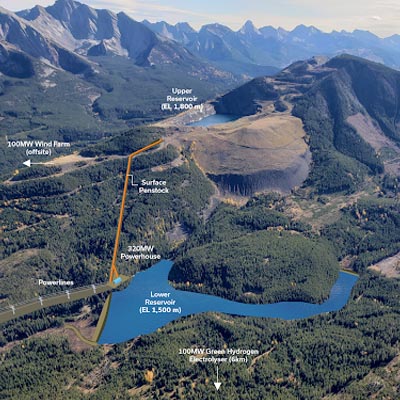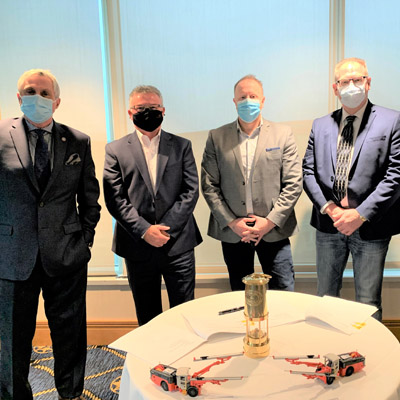Opening portals for women in mining
With a workforce deficit looming, the industry has more reason than ever to encourage women to choose mining.
While a few hardy female souls have been a part of the mining industry since the 1960s, for the most part women were not even legally allowed to work in mines until the late 1970s or early 1980s. Today, while women make up nearly 14 per cent of the mining industry, it’s still a very male-dominated profession. Opening the doors to access new opportunities can be a slow-going process, but it’s a process Women in Mining (WIM) Canada is hoping to make easier.
“I think it’s safe to say that the industry recognizes that gender does not determine talent,” said Catharine Shaw, who is vice president of WIM Canada. “Although there haven’t been a lot of women in the industry up until recently, the ones that have been out there for the long haul are brilliant women who are highly respected by both men and women alike.”
With many companies now actively recruiting women to careers in mining, there is an overwhelming need for an organization like Women in Mining Canada, Shaw said. That first became evident five years ago, when a networking reception held at the Prospectors and Developers Association of Canada’s (PDAC) convention held in Toronto brought in a overflowing room full of women looking to network.
Building on that response, WIM’s annual reception now attracts upwards of 800 women. Those numbers continue to grow, as do the number of women who are choosing careers in mining. She said that is partially because the industry itself has changed and become more appealing to women and partially because the word is getting out to younger women that mining is a viable career option.
Using that first reception as a building block, Shaw and other WIM Canada founders, including president Jean Lucas, decided that the time had come to give Canadian women a national voice to help not only attract and recruit women, but also help them stay in mining.
“We wanted to organize WIM Canada to help represent women in the industry, communicate the opportunities that are here and help women connect to those opportunities,” said Shaw. “There is a pool of talent here that is still unrepresented and what we hope to do is to build those bridges and help some of these women connect.”
Shaw herself works for the consulting firm Golder Associates in an office in Toronto, far away from the down-and-dirty work of frontline miners. But she said WIM Canada is an inclusive group that looks to support all women, whether they are haul truck drivers working underground, geologists, sales reps for drill rigs or environmental consultants. Whatever role women play, said Shaw, WIM wants to be there to support them.
That support comes in the form of mentorship programs where women support women, as well as networking opportunities at both the PDAC conference and the Canadian Institute of Mining, Metallurgy and Petroleum conference. In addition, WIM Canada provides opportunities for women to gain invaluable boardroom experience and looks to help both companies and individuals alike learn new ways to navigate the unique challenges women face, especially when it comes to dealing with home and family responsibilities.
“Not every woman wants to be a mom, but lots of them do,” said Shaw. “And a lot of women have family obligations and responsibilities, which can be a sideways step or a backwards step in their career. Traditionally, in the past there haven’t been a lot of mechanisms in place to encourage women to come back to work or to maintain their skills with continued education or training. The workplace environment itself wasn’t flexible and didn’t think of providing different ways in which women could keep their jobs, whether it be job sharing, shorter shifts or floating roles. But with the doors now really opening for women, the industry is now looking at ways they can be more creative in retaining this particular pool of talent.”
Shaw said she believes the mining industry will continue to actively seek female employees.
“In my opinion,” said Shaw, “whether women are employed or developing skills in traditional or non-traditional science or engineering roles, are working in administrative roles or are working directly underground or in open pits, they have a significant role to play in mining today. We’re seeing a lot of change coming forward in terms of recruitment strategies that now recruit women specifically.”
WIM continues to work in partnership with the industry in attracting women to mining careers.
“As an organization we want to help that initiative by reaching younger women when they’re still at university,” said Shaw. “Signing women up as members so that they can network and feel like they are part of something bigger. We want to provide that much-needed mentorship and to point to some of the ways companies can provide flexible part-time opportunities or help support families. We want to be that national voice.”
As to what she considers would be a successful implementation of all the tools of WIM Canada, Shaw said it’s a matter of making the organization redundant.
“We’d like to get to the point where there’s no longer a need for an organization like WIM,” said Shaw. “We want to do such a great job that one day the industry will be so balanced and so integrated that gender will no longer be an issue.”
That day has not yet arrived.
“Right now we see the need,” said Shaw. “We’re working to help bring opportunities to the table, to connect women in all aspects of mining and to help them to thrive in their careers.”
Branching out: origins of the Women in Mining organization
In Toronto back in the 1960s, a female geologist and writer profiled another female geologist for the Northern Miner magazine. Bonding over lunch, the pair found they had much in common in an industry where few women dared to tread. As their female colleagues heard of these informal luncheons, they began to join them and call themselves Women in Mining.
From those small beginnings a national organization has grown. Today lunches, guest speakers and other informal networking events continue to keep Women in Mining a thriving and vibrant networking opportunity, both in Toronto and across the country. The organization gives women the opportunity to speak with others in the industry who can understand the challenges they face and help them find solutions.
Independent and autonomous branches have been formed from Vancouver, British Columbia, to Val D’Or and Montreal in Quebec. There are four branches located in Manitoba and one recent start-up in Saskatchewan.
“WIM Canada is hoping one day to be the big sister to all of these branches and to give them a national voice, “ said Shaw. “We’ve recently helped to establish branches in a few places that didn’t have one, including Calgary and Northern Ontario, and we hope to help with more in the future. It’s a growing phenomenon happening right across the country.”




